Introduction
This tutorial is about finishing the edges of your weave with a border by crocheting slip stitches. This is an in depth tutorial, so you will get the best result. Visually, but also for attaching weaves to each other. I will try to explain this to you with lots of pictures. You can click on each picture or drawing to see a larger version.
I also made a video of it, but continue reading after the video link if you prefer that.
On the pictures you will see my weaving frame with 24 nails on each side, 4 corner nails and 22 nails in between them on each side to be exactly. On the drawings you see 10 nails on each side, so that’s a little bit different than my loom. But I will make that clear as much as I can where that is needed. It’s possible that your loom has another number of nails on the sides, but that doesn’t make a difference in the way to work. I will clarify things, where counting is done, or where there’s a link with the drawing.
This tutorial is split into several pages, because it has a lot of pictures and drawings. You will find the buttons to skip to the next or the previous page on the bottom of each page.
The crocheting of the sides is done while the weave is still on the loom.
The goal: the same number of crochet stitches on each side

This is a drawing that I made for explaining how to weave (see here for the tutorial). I marked the corners (ABCD), and I numbered the loops that are around the nails. In this example you see that you have 10 nails (the black circles) on each side. Or to be exact : 4 corner nails with 8 nails in between them on each side. You see that there are 9 side loops on the top, on the left only 8, 9 at the bottom, and 9 at the right side. And that actually is not what you want for a crochet border.
Preferably you would like to make a stitch around each nail, and 2 on each corner nail (which is 1 for each side), so that you will end up with 10 stitches on each side. I showed that in the next drawing. But to accomplish that, you have to make some ‘adjustments’. And you have to start at the right place.
Look especially at the last page, because it’s very important what you have to do there!

The start
 The starting corner is corner A. That’s the place where, at the start of the weaving, the thread goes around the 2 top right nails. The reason that you have to start there will get clear at the end of this tutorial.
The starting corner is corner A. That’s the place where, at the start of the weaving, the thread goes around the 2 top right nails. The reason that you have to start there will get clear at the end of this tutorial.
Making a slip stitch
First I will explain how to make the crochet stitches. You start with making a slip knot and putting that on your crochet hook:

Next you put your hook through the first corner loop (at nr 1):
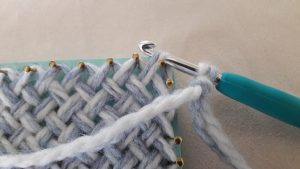
Put the yarn (that goes to the ball) over your hook:

Pull the yarn through the corner loop. You now have 2 loops on your hook.

Now pull the 2nd loop, the last one you made that is nearest to the tip of your hook, through the 1st loop of the slip knot. This is how the result looks:
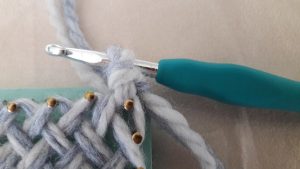
Next you do the same thing with the border loop around the 2nd nail. Put the hook through the 2nd sideloop:

Again put the yarn over the hook:
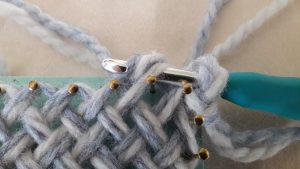
Pull the yarn through the 2nd sideloop:
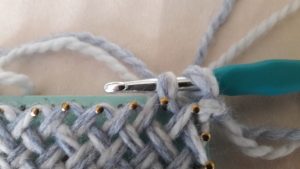
And again pull the 2nd loop on the hook through the 1st loop. This is how the result looks:
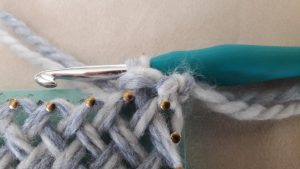
This is how it looks when you view it from the top:


You can clearly see 2 V-shapes. In the 2nd picture I put a stitch marker into the 1st stitch. That makes it easier for explaining, but it’s also easier for counting and to prevent you to go wrong.
Now make a slip stitch in each sideloop.
Continue on the next page for a trick when you have trouble getting these sideloops on your hook, and for further explanation on how to deal with corner B.

